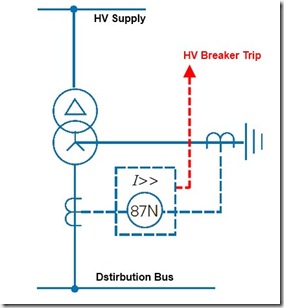Restricted Earth Fault Protection
The windings of many medium and small sized transformers are protected by restricted earth fault (REF) systems. The illustration shows the principal of REF protection.
Basic Operation

Restricted Earth Fault Operation Under normal conditions and by application of Kirchhoff’s laws the sum of currents in both current transformers (CTs) equals zero. If there is an earth fault between the CTs then some current will bypass the CT's and the sum of currents will not be zero. By measuring this current imbalance faults between the CTs can be easily identified and quickly cleared.
Fault detection is confined to the zone between the two CTs hence the name 'Restricted Earth Fault'.
REF protection is fast and can isolate winding faults extremely quickly, thereby limiting damage and consequent repair costs. If CTs are located on the transformer terminals only the winding is protected. However, quite often the secondary CT is placed in the distribution switchboard, thereby extending the protection zone to include the main cable.
Without REF, faults in the transformer star secondary winding need to be detected on the primary of the transformer by the reflected current. As the winding fault position moves towards the neutral, the magnitude of the current seen on the primary rapidly decreases and could potentially not be detected (limiting the amount of winding which can be protected). As the magnitude of the currents remain relatively large on the secondary (particularly if solidly earthed), nearly the entire winding can be protected using REF.
It should be remembered that the protection as illustrated covers only the secondary of the transformer. Sometimes REF protection is added to the primary as well (although if primary protection is required it may be preferable to consider full differential protection).
As it is essential that the current in the CTs be balanced during normal conditions (and through faults), historically REF has been implemented using High Impedance Relays. CT's have also been specified as matched pairs and the impedance of leads/wires and interconnecting cables has had a large influence on the functioning of the relay.
Measurement errors associated with mismatched CTs, saturation and varying lead resistance have been responsible for nuisance tripping and the system can be difficult to commission. This may be the reason some people avoid the use of REF. Recent advances in numerical relay technology have all but eliminated these issues, making the implementation of REF relatively easy, ensuring no nuisance tripping and simplifying commissioning.
In the diagram 87N is the ANSI Device Number for restricted earth fault.
See Also
ANSI (IEEE) Protective Device Numbering